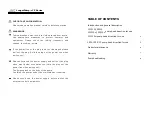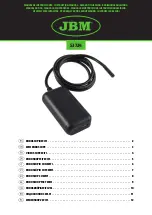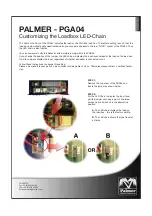
C-7 FORI SCARICO ACQUA
Il corpo cilindro della macchina è dotato di fori (
A
) che
permettono di scaricare l’eventuale acqua che scende
dallo strallo/testa albero.
C-8 CONSIGLI PER LA VELA
I dettagli costruttivi della vela, dei sui punti di
collegamento a testa, Cunningham e strallo devono
essere definiti in collaborazione con il velaio.
C-9 MONTAGGIO DELLA VELA
Per montare la vela occorre:
•
Legare l’angolo di penna al double lashing pin (
A
) al
di sotto della testa girevole con un lashing adeguato.
•
Dettagli del collegamento tra vela e strallo sono
in funzione della specifica costruzione della vela
e devono essere concordati preventivamente con
il velaio.
•
Legare l’angolo di mura alla parte superiore (
B
) del
Cunningham con un adeguato lashing.
•
Per il controllo del Cunningham, passare una
adeguata linea tessile all’interno delle apposite
asole nella parte inferiore (
C
) del Cunningham ed
attraverso i fori raggiati di attraversamento della
coperta collegandoli al sistema di tensionamento
previsto.
C-7 WATER DRAIN HOLES
The cylinder body is equipped with holes (
A
) that allow
for any possible water leaking down from the stay/mast
head to be drained.
C-8 SUGGESTIONS FOR THE SAIL
Sail constructive details, its connection points to the
halyard swivel, Cunningham and stay, have to be
defined in cooperation with the sail maker.
C-9 HOW TO HOIST THE SAIL
To hoist the sail you have to:
• Use an adequate lashing to tie the sail head to
the double lashing pin (
A
) fitted under the halyard
swivel.
• Connection details between sail and stay depend on
the sail specific construction and have to be agreed
upon in advance with the sail maker.
• Use an adequate lashing to tie the sail tack to the
upper part (
B
) of the Cunningham.
•
To control the Cunningham, first slide an adequate
textile line inside the appropriate slots in the lower
part (
C
) of the Cunningham. Then slide it through the
radius holes on deck. At this point, you may connect
the line to the tensioning system provided for.
C-10 USO DELL’AVVOLGIFIOCCO
Apertura della vela
•
Premere il pulsante di apertura vela e tirare la scotta del genoa.
Avvolgere la vela
•
Filare la scotta del genoa e premere il pulsante di chiusura vela. Nel
caso di riduzione della vela si consiglia di regolare la posizione del
carrello genoa.
PERICOLO
PERICOLO DI FOLGORAZIONE
ATTENZIONE
AVVERTENZA
RISPETTA L'AMBIENTE
La maggior parte delle vele si allungano con l’utilizzo. I velai dovrebbero
tener conto di questo allungamento al momento della determinazione
della lunghezza del gratile. Fate in modo che la testa girevole non vada
oltre i profili, si consiglia una distanza di 5÷10 cm tra il lato superiore della
testa girevole e l’anello di fermo del profilo terminale.
C-10 HOW TO USE THE FURLER
Open the sail
• Press the “open sail” switch and pull the genoa sheet.
Furl the sail in
• Slack away the genoa sheet by placing a slight drag on it and press
the “close sail” switch. If you want to reef the sail, the genoa traveler
should be moved forward at every stage of reefing in order to maintain
the correct sheeting angle.
DANGER
DANGER OF ELECTROCUTION
CAUTION
WARNING
RESPECT THE ENVIRONMENT
Most sails stretch permanently with use.Sailmakers should compensate
for this permanent stretch when determining the luff length. Do not over
tension the halyard swivel above the top end of the foils, we suggest a
distance of 5 to 10 cm between the top edge of the halyard swivel and
the top end of the extrusions.
A
ISTRUZIONI DI MONTAGGIO E USO
INSTALLATION AND USE
C
15
um_cts_it-en_rev. 05/2022
A
B
C
Содержание GFSI CTS
Страница 33: ...33 um_cts_it en_rev 05 2022 NOTE NOTE ...
Страница 34: ...34 um_cts_it en_rev 05 2022 NOTE NOTE ...
Страница 35: ......
















































